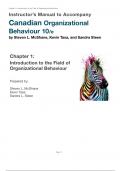Exam (elaborations)
Solutions Manual For Canadian Organizational Behaviour 10th Edition by Steven McShane. isbn. 978-1259271304.
- Course
- Human resources management
- Institution
- Human Resources Management
Solutions & Solutions Manual For Canadian Organizational Behaviour 10th Edition by Steven McShane, Kevin Tasa and steen. Canadian Organizational Behaviour 10e solutions. McShane 10e solutions for Canadian Organizational Behaviour.
[Show more]



